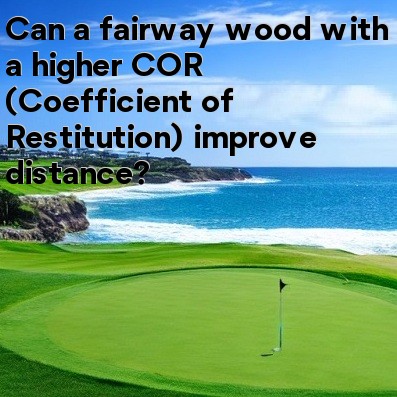
In golf, Can a fairway wood with a higher COR (Coefficient of Restitution) improve distance?
When it comes to fairway woods in golf, the main objective for most players is to achieve maximum distance off the tee or from the fairway. One factor that can potentially contribute to increased distance is the COR or the Coefficient of Restitution of the clubface.
The Coefficient of Restitution is a measurement of how efficiently a clubface transfers energy to the golf ball upon impact. The higher the COR value, the more energy is transferred, resulting in greater distance. So, in theory, a fairway wood with a higher COR could indeed improve distance compared to one with a lower COR value.
However, it's important to note that the COR of a fairway wood is regulated by the USGA (United States Golf Association) and R&A (The Royal and Ancient Golf Club of St Andrews). They have set a maximum COR limit of 0.830 for golf clubs, including fairway woods. This limit ensures a level playing field and prevents clubs from providing unfair advantages.
Within the allowed limits, fairway wood manufacturers have the freedom to design clubfaces that optimize the COR. They achieve this by using different materials and technologies to maximize energy transfer. For example, they may incorporate a thin, flexible clubface or utilize weight redistribution to push the boundaries of the COR limit.
So, while a fairway wood with a higher COR may have the potential to improve distance, it's important to consider that many other factors contribute to a golfer's overall performance.
Factors Affecting Distance:
1. Swing Speed: The speed at which a golfer swings the club is a key factor in determining distance. A faster swing speed generates more energy, resulting in longer shots. While a high COR fairway wood can optimize energy transfer, it cannot make up for a slow swing speed.
2. Launch Angle: The launch angle at which the ball leaves the clubface also affects distance. The ideal launch angle varies depending on factors such as the golfer's swing style, club loft, and conditions. Achieving the optimal launch angle requires proper technique and understanding of individual factors.
3. Clubhead Design: Apart from COR, fairway wood design features such as face construction, weight distribution, and clubhead shape can affect distance. Each golfer may have individual preferences based on their swing style or playing conditions, which could impact overall performance.
4. Shaft Flex and Length: The flex and length of the fairway wood shaft also play a role in distance. The proper shaft stiffness and length for an individual golfer can help optimize their swing, leading to improved distance.
Conclusion:
While a fairway wood with a higher COR value has the potential to improve distance within the regulations set by the USGA and R&A, it is just one of many factors that impact how far a golfer can hit the ball. Swing speed, launch angle, clubhead design, and shaft characteristics are all crucial considerations in achieving optimal distance. Ultimately, finding the right combination of these factors for an individual golfer's swing style and preferences is key to maximizing performance.





